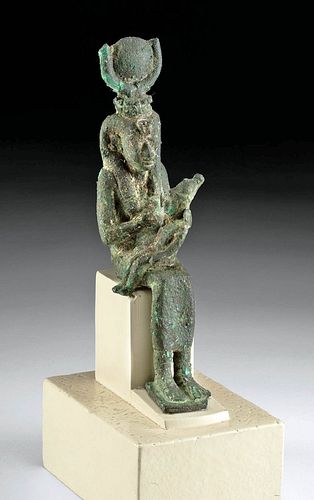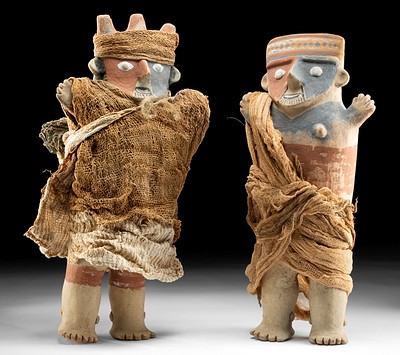Egyptian Bronze Seated Figure Isis Nursing Horus
Lot 7a
About Seller
Artemis Fine Arts
686 S Taylor Ave, Ste 106
Louisville, CO 80027
United States
Selling antiquities, ancient and ethnographic art online since 1993, Artemis Gallery specializes in Classical Antiquities (Egyptian, Greek, Roman, Near Eastern), Asian, Pre-Columbian, African / Tribal / Oceanographic art. Our extensive inventory includes pottery, stone, metal, wood, glass and textil...Read more
Categories
Estimate:
$3,000 - $4,500
Absentee vs Live bid
Two ways to bid:
- Leave a max absentee bid and the platform will bid on your behalf up to your maximum bid during the live auction.
- Bid live during the auction and your bids will be submitted real-time to the auctioneer.
Bid Increments
| Price | Bid Increment |
|---|---|
| $0 | $25 |
| $300 | $50 |
| $1,000 | $100 |
| $2,000 | $250 |
| $5,000 | $500 |
| $10,000 | $1,000 |
| $20,000 | $2,500 |
| $50,000 | $5,000 |
| $100,000 | $10,000 |
| $200,000 | $20,000 |
About Auction
By Artemis Fine Arts
May 19, 2022
Set Reminder
2022-05-19 10:00:00
2022-05-19 10:00:00
America/New_York
Bidsquare
Bidsquare : Fine Antiquities | Ethnographica | Fine Art
https://www.bidsquare.com/auctions/artemis-gallery/fine-antiquities-ethnographica-fine-art-9350
Featuring a very special collection of Fine Art from the Hollywood Hills, including Picasso & Rookwood ceramics! Also included are many fine examples of classical antiquities, ancient, and ethnographic art from cultures encompassing the globe. Artemis Fine Arts info@artemisgallery.com
Featuring a very special collection of Fine Art from the Hollywood Hills, including Picasso & Rookwood ceramics! Also included are many fine examples of classical antiquities, ancient, and ethnographic art from cultures encompassing the globe. Artemis Fine Arts info@artemisgallery.com
- Lot Description
Egypt, Late Dynastic to Ptolemaic Period, ca. 664 to 30 BCE. A skillfully cast copper alloy (bronze) figure depicting Isis - goddess of healing and magic - as she nurses her son, Horus, in her lap. Displayed in a seated position, Isis presents with bare feet placed atop an integral plinth, wearing a knee-length skirt, and grasping one exposed breast with her hand to position it near Horus' face. Isis' face protrudes outward above her breasts and features almond-shaped eyes, a full nose and lips, and cupped ears, all beneath a large tripartite wig with a frontal uraeus cobra, long lappets, a crown of uraeus cobras, and a pair of Hathoric horns flanking a sun disc. Horus faces nude to Isis' right side, has both arms draped down his sides, and wears the Pschent crown that symbolizes the unification via divine authority of Upper and Lower Egypt. Size: 3.875" L x 2.1" W x 8.3" H (9.8 cm x 5.3 cm x 21.1 cm); 10.375" H (26.4 cm) on included custom stand.
Cf. The Metropolitan Museum of Art, accession number 45.4.4
Provenance: ex-Nancy and Dr. E.F. Simpson collection, Los Angeles, California, USA, acquired from 1970 to 2000
All items legal to buy/sell under U.S. Statute covering cultural patrimony Code 2600, CHAPTER 14, and are guaranteed to be as described or your money back.
A Certificate of Authenticity will accompany all winning bids.
PLEASE NOTE: Due to recent increases of shipments being seized by Australian & German customs (even for items with pre-UNESCO provenance), we will no longer ship most antiquities and ancient Chinese art to Australia & Germany. For categories of items that are acceptable to ship to Australia or Germany, please contact us directly or work with your local customs brokerage firm.
Display stands not described as included/custom in the item description are for photography purposes only and will not be included with the item upon shipping.
#172216Restoration to Isis' left elbow and areas of frontal uraeus cobra, with resurfacing along new material. Losses to horn tips, front of Horus' left foot, and proper front left corner of plinth. Encrustations and softening to finer details commensurate with age, with nicks and chips to Isis and Horus, and rough surface texture. Nice preservation to overall form and great patina throughout. Tangs beneath Isis' posterior and beneath integral plinth.Condition
- Shipping Info
-
All shipping is handled in-house for your convenience. Your invoice from Artemis Gallery will include shipping calculation instructions. If in doubt, please inquire BEFORE bidding for estimated shipping costs for individual items.
-
- Buyer's Premium



 EUR
EUR CAD
CAD AUD
AUD GBP
GBP MXN
MXN HKD
HKD CNY
CNY MYR
MYR SEK
SEK SGD
SGD CHF
CHF THB
THB













